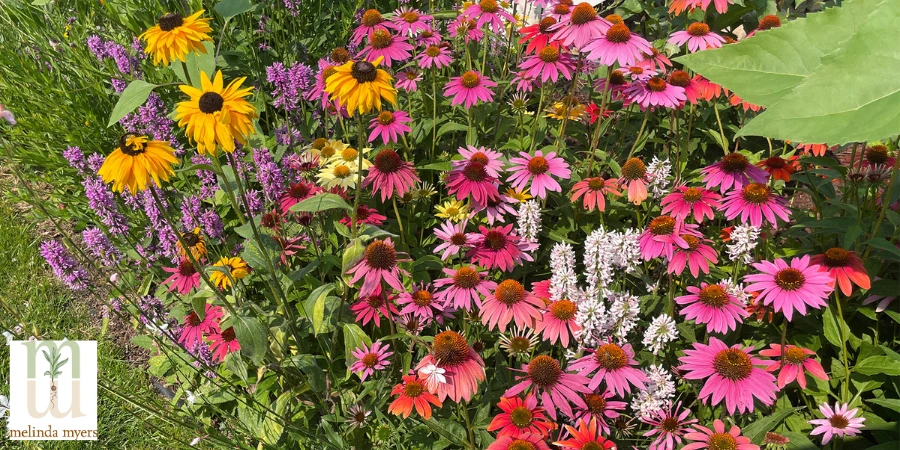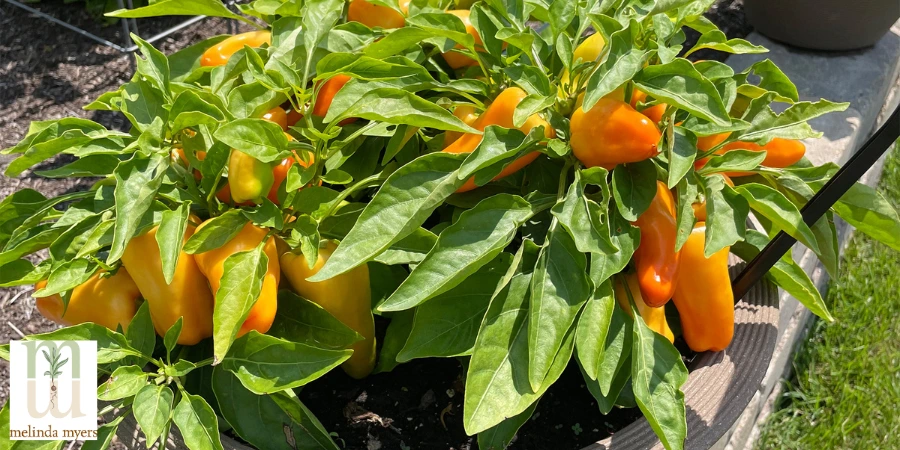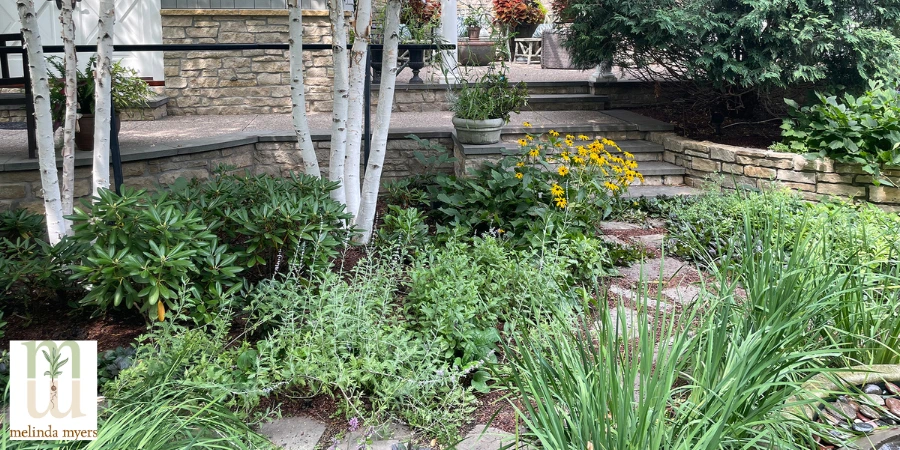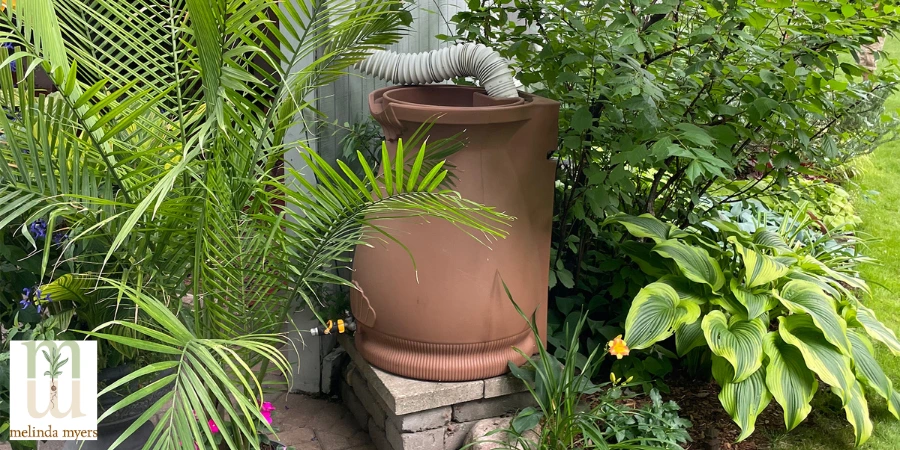Earth Day Every Day
- horticulturist and gardening expertApril 22, 2025
Earth Day is a reminder to make a difference every day when caring for our gardens and landscapes. Gardening sustainably is one way we can all make a difference as we work together to be kinder to the environment.
The goal of sustainable landscaping is to minimize our negative impact on the environment and promote a healthier outcome as we plan, plant and maintain our outdoor spaces. We can create more sustainable landscapes by conserving resources used and wasting less.
DIY Sustainable Gardening Practices

Proper Plant Selection
Selecting the right plant for the growing conditions will help you grow healthier plants that have fewer problems, need fewer resources, and need less of your time and attention. Make sure they will fit the location once they reach their mature size. Not only will they look their best, but you will not need to try to spend lots of time and energy trying to contain their growth and recycle lots of trimmings.
Look for plants that support pollinators we depend upon for much of our food, medicine, and next year’s plants for the garden. Create a habitat that also supports beneficial insects, songbirds, and other members of our community. Many help manage garden pests while adding color and motion to our gardens.
Include native plants whenever possible and appropriate for the space and growing conditions. Look for those that are less aggressive if gardening in limited space. Start by adding one or two to existing gardens as opportunities arise. Then consider creating a garden of native plants. You will be amazed at the increase in pollinators, beneficial insects, and songbirds that follow.

Native Plants
Improve and Protect Soil
Most of us start with less-than-ideal soil. Improving and protecting soil from erosion and compaction allows us to grow healthier, more productive, and beautiful plants that require fewer resources and less of our time to maintain.
Boost your soil’s health with the addition of compost. Spread a layer of compost over your lawn and existing gardens or incorporate it into the soil, adding nutrients and organic matter. Compost improves drainage in heavy soils, increases water holding ability in fast-draining soils, and improves the soil’s ability to absorb rainwater. This means more water stays on your landscape for your plants and less runs off into our storm sewers and waterways.
Keep the soil covered year-round with plants and mulch to help protect it from erosion, soil compaction, and the infiltration of weeds. Growing a variety of plants and keeping the soil filled with roots year-round supports soil microbes that help create healthy soil. As the old roots decompose, they add organic matter to the soil and create pathways for stormwater to enter the soil. As the water travels past the roots and through the soil much of the dust and pollutants are removed along the way.
Consider growing cover crops in vacant garden beds. Planting these quick-growing, short-lived plants covers the soil, adds nutrients and organic matter, and suppresses weeds.
Grow a Food Garden
Grow some of your own fruits, vegetables, and herbs. You’ll reduce energy consumption used for transporting food an average of 1800 miles from the farm to your home. You’ll also enjoy the flavor and higher nutritional content of vegetables harvested from your own garden.

Peppers from Heaven - Mini Peppers
Don’t let limited space stop you from growing garden-fresh fruits, vegetables, and herbs. Look for new compact varieties suitable for containers and small space gardens. Then supplement your harvest with seasonal produce purchased at your local farmer’s market.
DIY Sustainable Lawn
Growing an eco-friendlier lawn starts by evaluating your current lawn’s health, purpose, and size. We use lawns for play areas and pathways and connect various elements within the landscape.

Alternatives to grass
Consider how you currently or soon will use those grassy patches. Determine how much lawn area is needed and if there are more sustainable options to a traditional lawn. Many gardeners are growing no-mow lawns, adding bee-friendly plants to their lawn grass, or opting for more drought-tolerant lawn grasses like turf-type tall fescues, buffalograss, and Habiturf native lawn mix. Whichever option you select, make sure it is suited to your growing conditions and will provide the results you desire.
Review and Adjust Your Lawn Care Practices
Mowing
Raise the mowing height of your lawn if you have not already done so. Taller grass is better able to compete with weeds and is more drought-tolerant. Remove no more than one-third of the total height to reduce the stress on the grass plants. Leave the short clippings on the lawn adding organic matter and nutrients to the soil. A season’s worth of clippings is equal to one fertilizer application.
Sharpen your mower blades. You’ll save time, money, and improve the look of your lawn. Dull blades tear the grass, resulting in a dull or brownish cast to the lawn. These ragged edges are slow to close, increasing the risk of disease. You’ll also save time as you can cut more efficiently when the blades are sharp. Speaking of savings, you’ll use 22% less fuel and the lawn will use up to 30% less water when using sharp blades.

Watering
Allow your lawn to go dormant during hot dry weather. Minimize foot traffic and play, and don’t apply herbicides and fertilizer to dormant lawns. This can damage the grass and new weeds, not grass, replace those killed by the weedkiller, while the fertilizer helps the weeds grow.
Fertilization
Maintain a healthy lawn with proper fertilization. University of Minnesota research showed that properly fertilized lawns do a better job of holding soil and nutrients in place than unfertilized lawns. This means less phosphorus run-off polluting our waterways.
Test your soil to ensure you use the right type and amount of fertilizer for your lawn. Proper fertilization with a low-nitrogen, slow-release fertilizer, like Milorganite, encourages dense cover and deep roots that are more drought, pest, and disease tolerant and better able to outcompete weeds. Milorganite has been in production since 1926, making it one of the oldest recycling efforts in the country, diverting billions of pounds of waste from landfills. They use pre-treated landfill gas so less natural gas and electricity is needed for its production
Always sweep grass clippings and fertilizer residue off the walks and drives. This simple step keeps unwanted nutrients out of waterways and eventually our drinking water.
Design & Maintain a Sustainable Landscape
Design for Energy efficiency
According to the U.S. Dept. of Energy: “A well-placed tree, shrub or vine can deliver effective shade, act as a windbreak and reduce your energy bills. Carefully positioned trees can save up to 25% of the energy a typical house uses.”
About 30% of your home’s heating energy is lost through windows. In cooling seasons, 76% of sunlight falls on standard double-pane windows and enters your home as heat. Plant trees on the east, southeast, west, and southwest sides of the house in the North and Midwest. Avoid evergreens on the south side of the house to allow warmth from winter sunshine inside.
Glass windows and doors can account for between 30 and 60% of a building’s heat gain in the summer. Southern gardeners should consider planting trees on the western, eastern and southern (in that order) side of their homes.
Manage Stormwater
Help keep water on your landscape and out of our storm sewers and waterways. You and your landscape will benefit by keeping this precious resource where it falls. Contact your local municipality to find out what stormwater management options are allowed and if there are any resources available to help you implement them.

Rain barrels have long been used to capture water. Use this to water ornamental plantings and container gardens. Consider linking several barrels together to maximize the water captured. Look for attractive ways to include these in your landscape. Paint, mask with decorative plantings, or select a stylish option, and make sure you still have easy access to the water.
Add a rain garden designed to capture stormwater runoff from your roof, lawn, walks, and other hard surfaces. Proper placement, soil preparation, and plant selection are important to create a properly functioning and attractive rain garden. When done correctly, the captured water will drain into the soil in about 24 hours and will not attract mosquitoes.
Plant and Care for Trees
You may know that trees help clean our air, shade, and shelter our homes from the sun and wind. They also slow and absorb rainwater, keeping it out of our storm sewers and reducing the risk of flooding.
Larger mature trees are able to manage more stormwater. Keeping your existing trees healthy is important to the environment as well as the beauty of your landscape. Start by extending the mulch ring around the tree to reduce competition with the lawn for water and nutrients. It makes mowing around the plants easier and reduces the risk of damaging them with weed whips and mowers.
Cover the soil surface with 2 to 3” of shredded bark, woodchips, or hardwood mulch. Pull the mulch away from the trunk of the tree to avoid rot, vole damage, and development of girdling roots around the trunk.
Water existing trees thoroughly as needed. Even established trees benefit from thorough watering during hot dry weather. Appy 10 gallons of water for every inch diameter of trunk measured at 4 ½’. Water the area under the drip line thoroughly and several feet beyond for evergreens.
Start a Compost Pile
Convert disease-free and insect-free plant debris and plant-based kitchen scraps into a valuable soil amendment. Don’t add annual weeds gone to seed, perennial weeds, and invasive plants to your compost, as most of our compost piles don’t kill these, and these problems end up back in the garden. Keep meat, bones and dairy that attract rodents out of the compost pile. Check with your local municipality as some require specific composters in their communities.
Incorporate finished compost into the top 8 to 12 inches of garden soil, spread an inch over your perennial flowerbeds and lawn or add it to your container potting mix. Your compost helps improve drainage in heavy clay soils and increases the water-holding ability of fast-draining sandy soil. Plus, you’ll burn a few calories and tone up your oblique muscles when turning the pile. That means you can have that cookie for dessert.
As Gaylord Nelson, founder of Earth Day said “The ultimate test of man's conscience may be his willingness to sacrifice something today for future generations whose words of thanks will not be heard.”
So, let’s all invest some time and effort now and throughout the year to create a better environment for future generations to enjoy.

